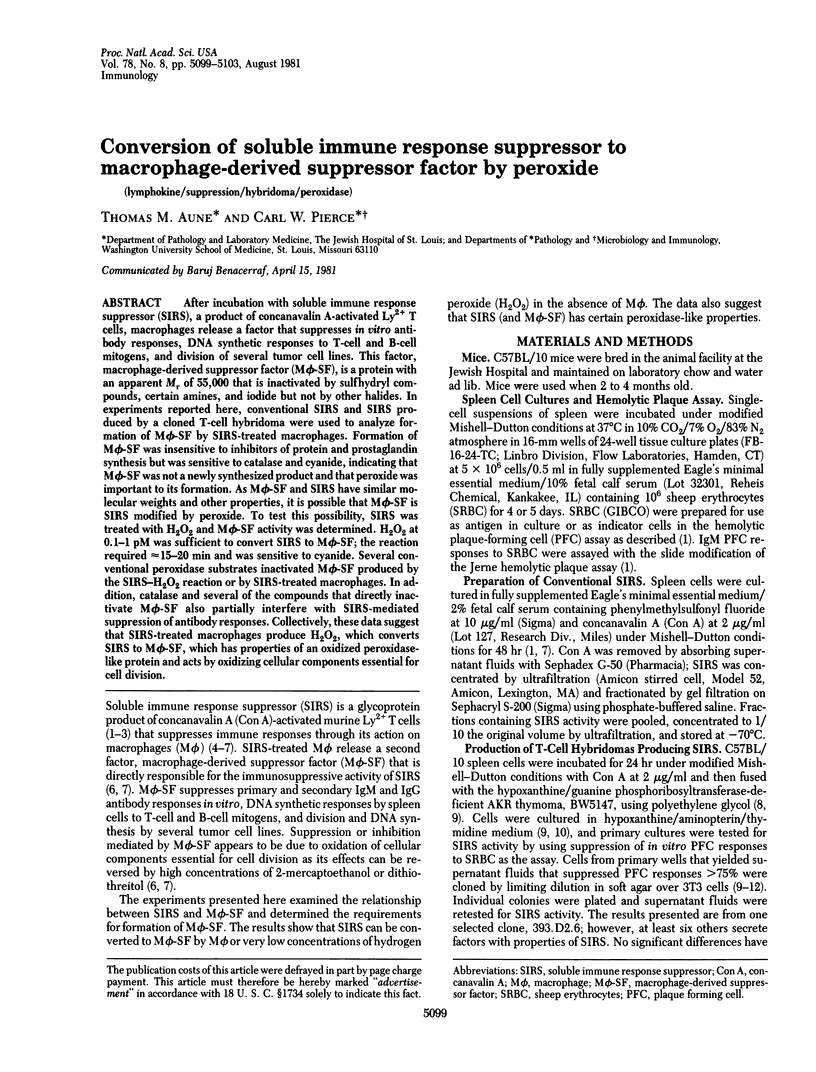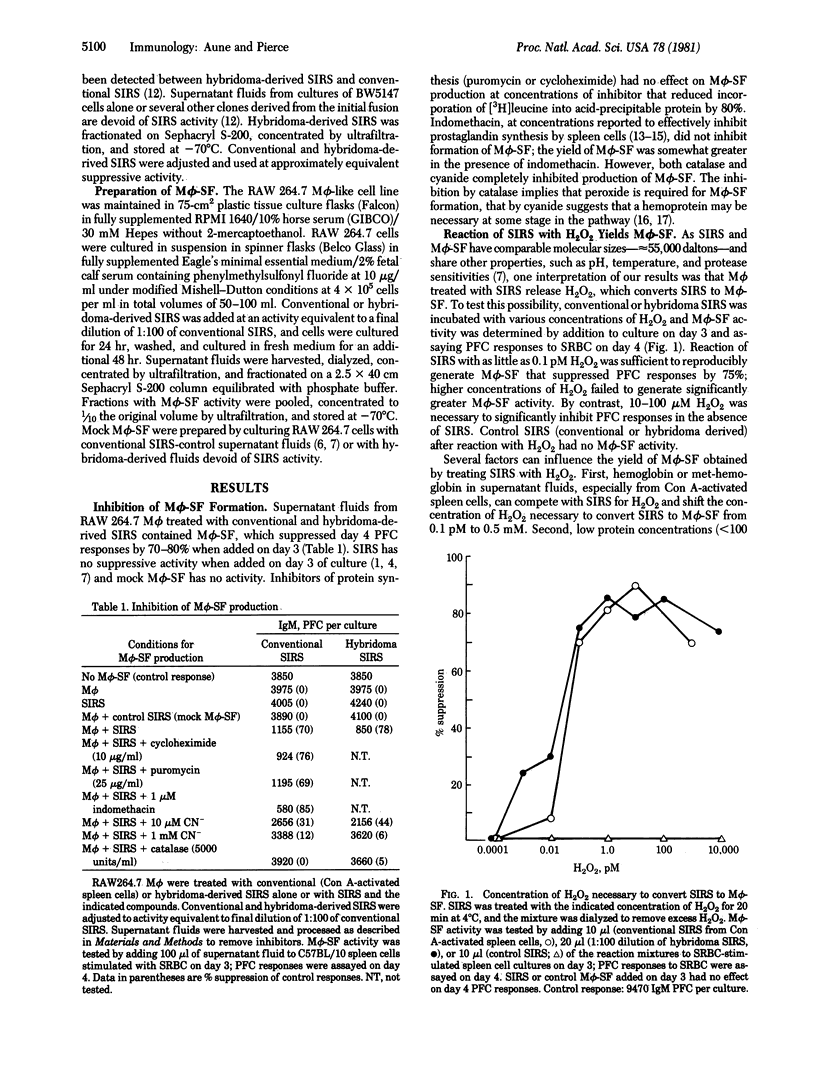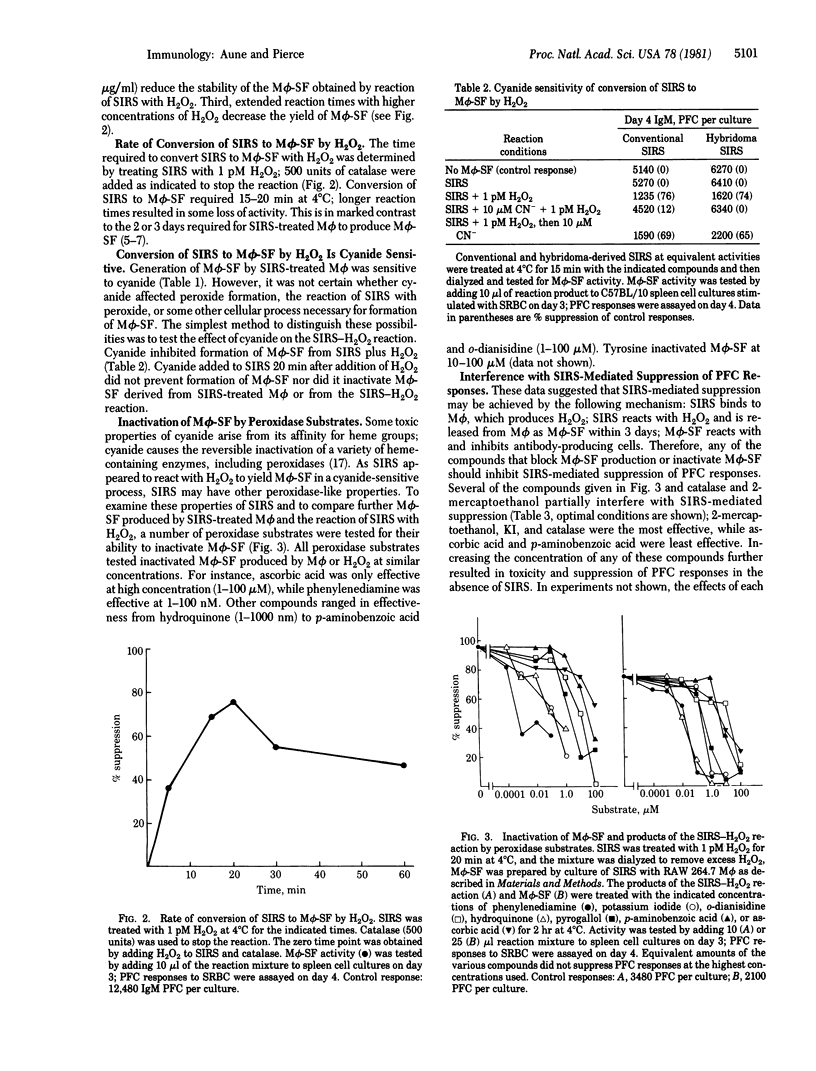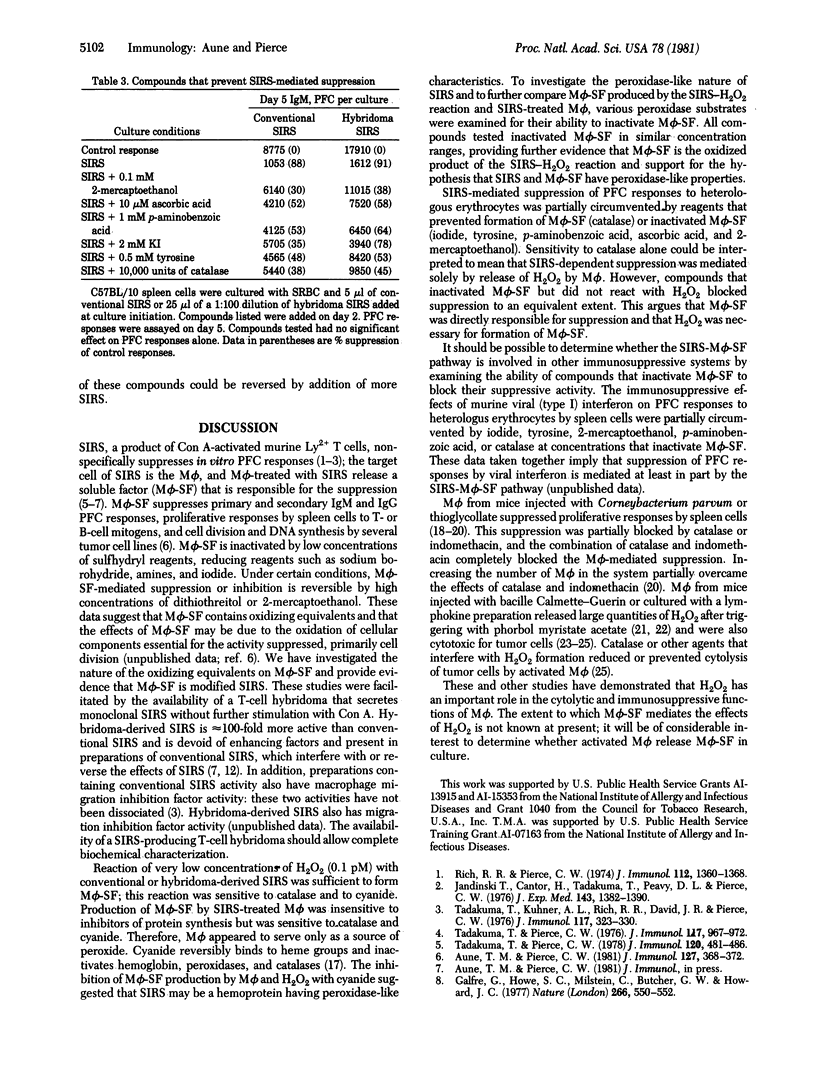Abstract
After incubation with soluble immune response suppressor (SIRS), a product of concanavalin A-activated Ly2+ T cells, macrophages release a factor that suppresses in vitro antibody responses, DNA synthetic responses to T-cell and B-cell mitogens, and division of several tumor cell lines. This factor, macrophage-derived suppressor factor (M phi-SF), is a protein with an apparent Mr of 55,000 that is inactivated by sulfhydryl compounds, certain amines, and iodide but not by other halides. In experiments reported here, conventional SIRS and SIRS produced by a cloned T-cell hybridoma were used to analyze formation of M phi-SF by SIRS-treated macrophages. Formation of M phi-SF was insensitive to inhibitors of protein and prostaglandin synthesis but was sensitive to catalase and cyanide, indicating that M phi-SF was not a newly synthesized product and that peroxide was important to its formation. As M phi-SF and SIRS have similar molecular weights and other properties, it is possible that M phi-SF is SIRS modified by peroxide. To test this possibility, SIRS was treated with H2O2 and M phi-SF activity was determined. H2O2 at 0.1-1 pM was sufficient to convert SIRS to M phi-SF; the reaction required approximately 15-20 min and was sensitive to cyanide. Several conventional peroxidase substrates inactivated M phi-SF produced by the SIRS-H2O2 reaction or by SIRS-treated macrophages. In addition, catalase and several of the compounds that directly inactivate M phi-SF also partially interfere with SIRS-mediated suppression of antibody responses. Collectively, these data suggest that SIRS-treated macrophages produce H2O2, which converts SIRS to M phi-SF, which has properties of an oxidized peroxidase-like protein and acts by oxidizing cellular components essential for cell division.
Full text
PDF




Selected References
These references are in PubMed. This may not be the complete list of references from this article.
- Aune T. M., Pierce C. W. Mechanism of action of macrophage-derived suppressor factor produced by soluble immune response suppressor-treated macrophages. J Immunol. 1981 Jul;127(1):368–372. [PubMed] [Google Scholar]
- Coffino P., Baumal R., Laskov R., Scharff M. D. Cloning of mouse myeloma cells and detection of rare variants. J Cell Physiol. 1972 Jun;79(3):429–440. doi: 10.1002/jcp.1040790313. [DOI] [PubMed] [Google Scholar]
- Galfre G., Howe S. C., Milstein C., Butcher G. W., Howard J. C. Antibodies to major histocompatibility antigens produced by hybrid cell lines. Nature. 1977 Apr 7;266(5602):550–552. doi: 10.1038/266550a0. [DOI] [PubMed] [Google Scholar]
- Grimm W., Seitz M., Kirchner H., Gemsa D. Prostaglandin synthesis in spleen cell cultures of mice injected with Corynebacterium parvum. Cell Immunol. 1978 Oct;40(2):419–426. doi: 10.1016/0008-8749(78)90349-0. [DOI] [PubMed] [Google Scholar]
- Humes J. L., Bonney R. J., Pelus L., Dahlgren M. E., Sadowski S. J., Kuehl F. A., Jr, Davies P. Macrophages synthesis and release prostaglandins in response to inflammatory stimuli. Nature. 1977 Sep 8;269(5624):149–151. doi: 10.1038/269149a0. [DOI] [PubMed] [Google Scholar]
- Jandinski J., Cantor H., Tadakuma T., Peavy D. L., Pierce C. W. Separation of helper T cells from suppressor T cells expressing different Ly components. I. Polyclonal activation: suppressor and helper activities are inherent properties of distinct T-cell subclasses. J Exp Med. 1976 Jun 1;143(6):1382–1390. doi: 10.1084/jem.143.6.1382. [DOI] [PMC free article] [PubMed] [Google Scholar]
- Kapp J. A., Araneo B. A., Clevinger B. L. Suppression of antibody and T cell proliferative responses to L-glutamic acid60-L-alanine30-L-tyrosine10 by a specific monoclonal T cell factor. J Exp Med. 1980 Jul 1;152(1):235–240. doi: 10.1084/jem.152.1.235. [DOI] [PMC free article] [PubMed] [Google Scholar]
- Keller R. Major changes in lymphocyte proliferation evoked by activated macrophages. Cell Immunol. 1975 Jun;17(2):542–551. doi: 10.1016/s0008-8749(75)80058-x. [DOI] [PubMed] [Google Scholar]
- Kirchner H., Holden H. T., Herberman Splenic suppressor macrophages induced in mice by injection of Corynebacterium parvum. J Immunol. 1975 Nov;115(5):1212–1216. [PubMed] [Google Scholar]
- LITTLEFIELD J. W. SELECTION OF HYBRIDS FROM MATINGS OF FIBROBLASTS IN VITRO AND THEIR PRESUMED RECOMBINANTS. Science. 1964 Aug 14;145(3633):709–710. doi: 10.1126/science.145.3633.709. [DOI] [PubMed] [Google Scholar]
- Meltzer M. S., Tucker R. W., Sanford K. K., Leonard E. J. Interaction of BCG-activated macrophages with neoplastic and nonneoplastic cell lines in vitro : quantitation of the cytotoxic reaction by release of tritiated thymidine from prelabeled target cells. J Natl Cancer Inst. 1975 May;54(5):1177–1184. doi: 10.1093/jnci/54.5.1177. [DOI] [PubMed] [Google Scholar]
- Metzger Z., Hoffeld J. T., Oppenheim J. J. Macrophage-mediated suppression. I. Evidence for participation of both hdyrogen peroxide and prostaglandins in suppression of murine lymphocyte proliferation. J Immunol. 1980 Feb;124(2):983–988. [PubMed] [Google Scholar]
- Morrison M., Schonbaum G. R. Peroxidase-catalyzed halogenation. Annu Rev Biochem. 1976;45:861–888. doi: 10.1146/annurev.bi.45.070176.004241. [DOI] [PubMed] [Google Scholar]
- Nathan C. F., Brukner L. H., Silverstein S. C., Cohn Z. A. Extracellular cytolysis by activated macrophages and granulocytes. I. Pharmacologic triggering of effector cells and the release of hydrogen peroxide. J Exp Med. 1979 Jan 1;149(1):84–99. doi: 10.1084/jem.149.1.84. [DOI] [PMC free article] [PubMed] [Google Scholar]
- Nathan C. F., Root R. K. Hydrogen peroxide release from mouse peritoneal macrophages: dependence on sequential activation and triggering. J Exp Med. 1977 Dec 1;146(6):1648–1662. doi: 10.1084/jem.146.6.1648. [DOI] [PMC free article] [PubMed] [Google Scholar]
- Nathan C. F., Silverstein S. C., Brukner L. H., Cohn Z. A. Extracellular cytolysis by activated macrophages and granulocytes. II. Hydrogen peroxide as a mediator of cytotoxicity. J Exp Med. 1979 Jan 1;149(1):100–113. doi: 10.1084/jem.149.1.100. [DOI] [PMC free article] [PubMed] [Google Scholar]
- Nathan C., Nogueira N., Juangbhanich C., Ellis J., Cohn Z. Activation of macrophages in vivo and in vitro. Correlation between hydrogen peroxide release and killing of Trypanosoma cruzi. J Exp Med. 1979 May 1;149(5):1056–1068. doi: 10.1084/jem.149.5.1056. [DOI] [PMC free article] [PubMed] [Google Scholar]
- Rich R. R., Pierce C. W. Biological expressions of lymphocyte activation. 3. Suppression of plaque-forming cell responses in vitro by supernatant fluids from concanavalin A-activated spleen cell cultures. J Immunol. 1974 Apr;112(4):1360–1368. [PubMed] [Google Scholar]
- Tadakuma T., Kühner A. L., Rich R. R., David J. R., Pierce C. W. Biological expressions of lymphocyte activation. V. Characterization of a soluble immune response suppressor (SIRS) produced by concanavalin A-activated spleen cells. J Immunol. 1976 Jul;117(1):323–330. [PubMed] [Google Scholar]
- Tadakuma T., Pierce C. W. Mode of action of a soluble immune response suppressor (SIRS) produced by concanavalin a-activated spleen cells. J Immunol. 1978 Feb;120(2):481–486. [PubMed] [Google Scholar]
- Tadakuma T., Pierce C. W. Site of action of a soluble immune response suppressor (SIRS) produced by concanavalin A-activated spleen cells. J Immunol. 1976 Sep;117(3):967–972. [PubMed] [Google Scholar]
- Webb D. R., Jr, Jamieson T. Control of mitogen-induced transformation: characterization of a splenic suppressor cell and its mode of action. Cell Immunol. 1976 Jun 1;24(1):45–57. doi: 10.1016/0008-8749(76)90130-1. [DOI] [PubMed] [Google Scholar]


